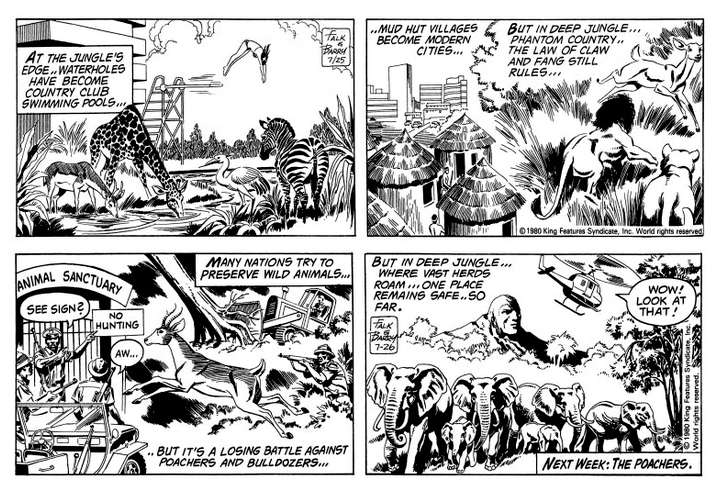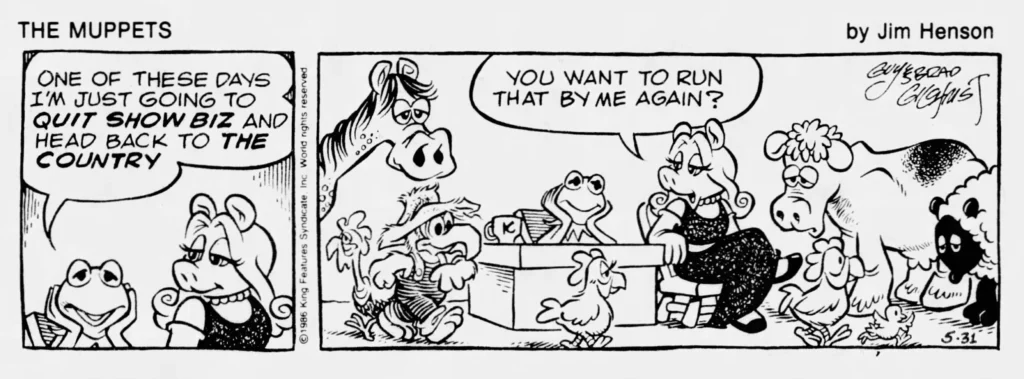The Phantom and The Muppets from the 1980s; Paul Bunyan from the early 20th Century, comic strip lettering from later in the 1900s; and the first Peanuts TV animation.

Hermes Press, the publisher of The Complete Phantom Dailies, missed an episode between Volume 29 and Volume 30. For those who didn’t keep track of our first mention of it and the update here is Hermes making things right for their readers: the complete episode of the 1980 adventure “The Poachers” by Lee Falk and Sy Barry.
**********

And so, Henson hired young cartoonist Guy Gilchrist to write and draw a comic strip called Jim Henson’s Muppets. It debuted worldwide on September 21, 1981, and during its height, The Muppets strip appeared in more than a thousand newspapers in 80 different countries and continued daily until May 31, 1986. I recently spoke with Gilchrist about bringing the Muppets to the funny papers

The Muppets comic strip roll out didn’t go without a hitch as in July of 1981 a couple rival Philadelphia papers battled for the opportunity to carry “the hottest and best comic strip” then being offered:

**********

Before there was fake news, there were tall tales. Often associated with the history of westward expansion, most of these tales carried expiration dates, their relevance fading in a dramatically changed world. But others turned out to have staying power as implausible as the mythic characters they celebrate.
In 1916, when W.B. Laughead, an advertising manager for Minnesota’s Red River Timber Company, published a pamphlet to promote the logging industry, a minor figure in Midwestern folklore underwent a major growth spurt, expanding dramatically in physique and reputation.
“Paul Bunyan: The Invention of an American Legend,” by the cartoonist Noah Van Sciver, puts the spotlight on Laughead, who also wrote and illustrated the pamphlet.
The New York Times reviews Paul Bunyan: The Invention of An American Legend which emphasizes the importance of adman and illustrator W. B. Laughead in the rise of Paul Bunyan as an American folk hero.
More about William B. Laughead and his booklets at the Forest History Society.

**********



letterers above: Charles F. Armstrong (left); Frank Engli (middle); Boody Rogers (right)
Often lettering was considered an entry-level job, something for the new hire, the aspiring cartoonist, to do while learning the craft and working up to more creative tasks like inking and penciling. Many artists started that way. There may well have been lettering specialists on comic strips in the early 20th century who liked that work and stuck with it, but whose names are not known or recorded.
Another from Todd Klein’s blog: When Lettering Became a Profession.
**********

The release of a new Peanuts TV cartoon special prompts WRKR to dig up the first Peanuts TV animation.
It was during this conversation that we remembered how Peanuts had some footprints in Michigan, as the first time it was ever animated for television was for Detroit-based Ford Motor Company and a commercial that debuted in 1959.
(Ignore where some say, “This commercial was likely the first time a comic strip was adapted into animation” – not by a long shot.)
I just want to say that, if I were running a newspaper comics page, I would for sure put in a bid for the rights to “The Phantom and the Muppets.”